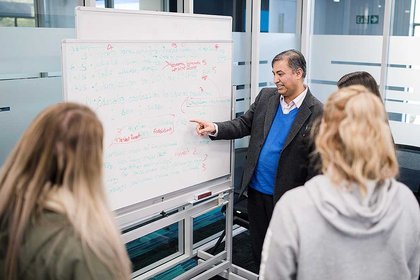
Associate Professor Imran Muhammad teaches transport and urban planning at the School of People, Environment and Planning.
By Associate Professor Imran Muhammad
Light rail investment has become a new arena of global competition to make the most liveable cities in the world. There are more than 35 cities in Australia, Canada and the United States alone that have built or are in the process of building light rail in their cities. Therefore, Government announcements on spending more than $14 billion on the Auckland Light Rail are not surprising.
Light rail is popular among politicians, as it has been associated with the “cool/modern image” of the 21st-century city and is considered a silver bullet to solve a range of problems such as environmental problems like carbon emissions related to transport, air quality, and urban sprawl, health problems such as physical activity and its ability to combat obesity, heart diseases and blood pressure, and mental health issues such as depression and isolation, economic problems such as regenerating cities/corridors for housing, retail and offices and transport problems such as congestion and the related energy usage.
However, very few studies have considered the huge investment into light rail from a transport justice perspective. Transport justice, as an extension of social justice, can be divided into process (inclusion in the decision-making process) and distributive (allocation of benefits and costs) justices.
Transport “process” justice will engage Māori, provide Māori with the opportunity to be involved in project governance and management roles, acknowledge and use their knowledge of the environmental health of Manukau Harbour, apply a Māori-inspired urban design framework in station design and conduct consultations as per the formal and informal planning practices in Auckland.
However, the real question is the issue of transport “distributive” justice: whether over 700,000 (46 per cent of the total population) Māori, Pacific and other ethnic communities living in Auckland will get benefit from the $14 billion investment into light rail.
The Māori population is mainly concentrated in southern and western suburbs such as Manurewa, Henderson–Massey, Papakura, Ōtara–Papatoetoe, Māngere–Ōtāhuhu and Franklin. Māori living in the south, especially Māngere, will get access to the light rail system, whereas Māori living in the northwest will have to wait until other light rail projects are planned in those areas.
Ethnic communities, especially Asian and Indian people, use nearly double the public transport in Auckland compared with the metropolitan average. The light rail route passing through Mt Roskill and Mt Albert provides an opportunity for these ethnic populations to transform an automobile-dependent city to a much more public-transport friendly city.
Light rail will connect two major employment hubs (the CBD and the Airport). However, the majority of Māori work all over the city and travel during non-peak periods, so might have limited use of the light rail system for job purposes. In contrast, the majority of the ethnic population is mainly involved in part-time work, and need good connections and off-peak services. Integrating light rail with other public transport services and frequency will determine the usage of services by ethnic minority communities.
Māori families are disproportionately dependent on cars because of their large family structures, health needs, the affordability of cars and the need to travel to meet cultural obligations. There is limited research available on Māori and public transport usage, but research on Māori and cycling shows that socio-economic inequities such as inflexible work conditions and lack of access to places of importance to Māori are creating barriers to cycling that might be relevant to light rail route and feeder design. Therefore, it is unlikely light rail will be well used by Māori. Although most ethnic communities consider cars as a status symbol, they are also excited to welcome “cool light rail” for social status reasons as well.
Auckland Council has advanced the light rail project as an urban development project to regenerate housing, retail and office buildings alongside the route, and have a larger impact on the overall city. On the one hand, it will be good for future urban development and for generating economic activities within the city. On the other hand, it may displace the low socio-economic population of Māori, Pacific and immigrants living near the light rail route. The Tāmaki Regeneration project and City Rail Link project show the complex interactions among authorities, community organisations and displaced population and businesses during the construction and regeneration period. Therefore, it is important to devise collaborative co-design and co-creation strategies that make light rail a tool for affordable housing, especially for transitioning Māori and ethnic populations to homeownership and small businesses.
The Māori, Pacific and immigrant-descent population in Tāmaki Makaurau is youthful. Therefore, the regeneration process should be carefully designed to involve youth, women and children to make a more equitable and secure future for them.
“Inclusive transport access” – enabling all people to participate in society through access to social and economic opportunities – is a key objective of the United Nations Sustainable Development Goals and the Government Policy Statements on transport produced by Labour in 2018 and 2021. However, there is limited research on how these aspirational goals will be achieved in the light rail project in Auckland.
As a public transport advocate, I am excited about the Government’s announcement of building a light rail system in Auckland, however light rail will be a fragile investment if the everyday travel needs of Māori, Pacific and ethnic communities will not be accommodated and the benefits of $14 billion will not be redistributive. Fostering this ethic of care for diverse people living in Auckland is key for academics and activists to continue reminding the Government and Auckland Council of their responsibility for social and transport justice.
Dr Muhammad teaches transport and urban planning at the School of People, Environment and Planning at Massey University.